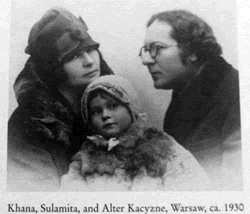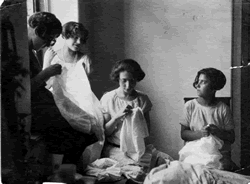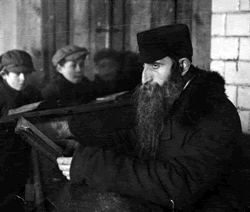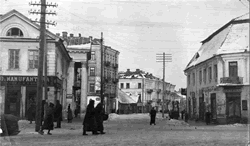Alter- Sholem Kacyzne
The Kacyzne family Warsaw c 1930.
(1885–1941), Yiddish writer and critic; photographer. Born in Vilna to a working-class family, Alter-Sholem Kacyzne (Yid., Katsizne) attended heder and also a Russian-language Jewish elementary school. At 14, after his father’s death, he stopped his formal studies. Kacyzne was an autodidact and remained an avid reader not only of literature in Russian, Yiddish, and Hebrew, but also of Polish, German, and French works. For about 11 years, he lived in Ekaterinoslav, where he learned to be a photographer and was married.
Young women embroidering, Kozienice, Poland, 1920s. Photograph by Alter Kacyzne. Kacyzne often suggested captions for the photographs he sent to the Forverts (The Forward) in New York. On this one, he wrote: “Embroidery is a widespread trade in the city.” (Forward Association/YIVO)
In 1909, Kacyzne first published two Russian stories in the periodical Evreiski mir (Jewish World), edited by S. An-ski. In 1910, attracted by the work and reputation of Y. L. Peretz, Kacyzne settled in Warsaw, where he opened a photography studio. He grew very close to Peretz, who became a literary mentor, but did not begin publishing in Yiddish until after Peretz’s death in 1915. Kacyzne’s first Yiddish texts appeared in collections in Vilna and Kiev. In 1919 and 1920 his first two books were published in Warsaw, the dramatic poems Der gayst der meylekh (The Spirit, the King) and Prometeus (Prometheus). He was also a consistent contributor to (and sometimes cofounder and coeditor of) a series of literary periodicals, most of them short-lived, in Warsaw and Vilna, in which he published novellas and stories that in 1922 appeared in book form as Arabeskn (Arabesques).
Kacyzne maintained a close intellectual friendship with An-ski. After the latter’s death in 1920, Kacyzne edited and completed An-ski’s unfinished play Tog un nakht (Day and Night), a project that pushed him to continue writing for the theater. His play Dukus (Duke), produced in Warsaw in 1925, achieved great success throughout Poland, Romania, and as far as Argentina. It was published as a book in 1926, as was Hurdus (Herod) that same year. Kacyzne also wrote for the Warsaw Literarishe bleter, and for a limited time served as coeditor. There and in other periodicals he regularly published poems, ballads, plays, and articles on literature, art, and social topics.
Crowd of emigrants in the shipping office of the Red Star-American Line, Warsaw, 1921. Photograph by Alter Kacyzne for the American organization HIAS (Hebrew Immigrant Aid Society). (Forward Association/YIVO)
Kacyzne’s career as a photographer reached its turning point in 1921 when the American organization HIAS (Hebrew Immigrant Aid Society) commissioned him to illustrate the misery of Polish Jews who were hoping to immigrate to the United States. Soon after, upon the invitation of editor Abraham Cahan, he began to send photographs on a regular basis to the New York Forverts (Forward), which printed them in its Sunday art supplement. Commissioned by the Forverts, Kacyzne traveled with his camera all over Poland, and also to Palestine, Romania, Italy, Spain, and Morocco. Photography became a second area of artistic creativity for him, and it supported his literary work, both economically and thematically.
In the late 1920s, Kacyzne composed his great two-volume novel Shtarke un shvakhe (The Strong and the Weak; 1929–1930). From 1934 to 1935, he was editor in chief of the ephemeral, Communist-oriented daily Der fraynd (The Friend). In 1936, he published the volume Baladn un groteskn (Ballads and Grotesques). Later he wrote three plays: Dem yidns opere (The Jew’s Opera), Ester (Esther), and Shvartsbard (about Sholem Schwartzbard, who assassinated the Ukrainian nationalist Symon Petliura in 1926). The first was not published during his lifetime; the other two were issued between 1937 and 1939 as installments in the periodical Mayn redndiker film (My Talking Film), which Kacyzne published with his own resources (and filled with his own creative writing, memoirs, and other articles). Kacyzne also translated from Russian to Yiddish and wrote the screenplay for the film Der dibek (The Dybbuk; 1937) based on An-ski’s play.
A teacher known as “Binyomin Hersh the Beard,” Bia?a Bielec, Poland, 1920s. Photograph by Alter Kacyzne. The photographer’s inscription: “The longest beard in Bia?a, which students have more than once nailed to the table while he dozes off. That’s why he has such wonderful, sad eyes.” (Forward Association/YIVO)
After the outbreak of World War II, Kacyzne left Warsaw with his wife and only daughter and found refuge in Soviet-occupied Lwów, where he participated in state-controlled theater and radio programs. Fleeing before the German advance, he arrived in Tarnopol and was killed on 7 July 1941, along with thousands of other Jews.
Alter Kacyzne considered himself and was considered by others to be Peretz’s foremost student. One can certainly identify a number of motifs and themes that testify to Peretz’s influence. Kacyzne was close to his teacher, most significantly in his inquisitive temperament that led him constantly to experiment with new forms and genres, and in his sense of social responsibility that drove him not only to write but also to pursue a program and a direction for Yiddish literature.
Kacyzne’s early dramatic poems are great aesthetic accomplishments more than anything else: “The motifs are not as original as they are masterfully executed” (Bal-Makhshoves). The Arabeskn show a great variety of experiments with modernist prose forms; the main story of the cycle Kranke perl (Sick Pearls), inspired by the Song of Songs, is a model of literary modernization of a biblical theme.
Jewish street in the shadow of a church, Luts’k, ca. 1926. Photograph by Alter Kacyzne. (Forward Association/YIVO)
The play Dukus is based on the legend of Count Walentyn Potocki, known as the Ger Tsedek of Vilna, who supposedly converted to Judaism and paid with his life for his loyalty to the Jewish faith. Dem yidns opere is based on the story of the Portuguese converso and comedy writer António José da Silva. Although both works are technically about martyrdom, they illuminate not so much the external confrontation between Jew and non-Jew as the utterly internal struggle between Jewish and non-Jewish elements within a Jewish person. Thus, despite being clothed as victims of the Inquisition, the characters in the latter work become spiritual incarnations of the modern Jew. In Shvartsbard and Ester (about a young Jewish woman revolutionary), Jewish characters are placed in authentic historical contexts, torn between national or social ideals and the pursuit of personal happiness.
The novel Shtarke un shvakhe presents a giant fresco of Jewish life in Warsaw and in Poland in the period surrounding World War I. One of the central figures is Berl Podlaski, a Jewish landowner with revolutionary ideas; his portrait was inspired by the personality of Kacyzne’s close friend, the Vilna art patron and publisher Boris Kletskin. The novel manages to depict the Jewish milieus of the day: worker associations, artistic circles, the world of writers and journalists, and everyday Jews. The plot is rich in fantasy episodes, intrigues, and unexpected twists; in it, one can recognize an artistic reworking of elements of the shund (trash) novel. Baladn un groteskn is distinguished by its loyalty to Peretz’s beloved folk sources and by a masterful domination of idioms and rhyme.
Street in the Jewish neighborhood, Bia?ystok, Poland, ca. 1920s. Photograph by Alter Kacyzne. (YIVO)
Thanks in large part to the efforts of the writer’s surviving daughter, Shulamis Kacyzne-Reale (1925–1999), the following books were published after the war: Geklibene shriftn (Selected Writings; 1951); Shtarke un shvakhe (1954); Gezamelte shriftn (Collected Writings; 4 volumes, 1967–1972) and Shvartsbard (1980).
Alter Kacyzne’s monumental archive of photographs in Warsaw was apparently entirely destroyed during the Holocaust. However, approximately 700 of the photographs had been sent to New York and are currently housed at the YIVO Institute. They combine the disciplined distance of the anthropologist and the loving nature of the artist. These images are first-class documents of Polish Jewry of the 1920s. They have often been reproduced in books, on CD covers, and as postcards. Polyn: Jewish Life in the Old Country (1999) includes a large selection of his images.
Suggested Reading
Carol Zemel, “Imagining the Shtetl: Diaspora Culture, Photography and East European Jews,” in Diaspora and Visual Culture, ed. Nicholas Morzoeff, pp. 193–206 (London, 2006); Kacyzne’s papers are held by YIVO (New York) and the Bibliothèque Medem (Paris).
YIVO Archival Resources
RG 1139, Abraham Cahan, Papers, 1906-1952; RG 1270, Alter Kacyzne, Collection, 1917-1930s; RG 453, Mendl Elkin, Papers, 1913-1961.
Author
Yitskhok Niborski
Translation
Translated from Yiddish by Yankl Salant
Alter with wife Khana
-
Alter Kacyzne (May 31, 1885 in Vilnius, Russian Empire – July 7, 1941 in Ternopil, Ukraine) was a Jewish (Yiddish) writer, poet and photographer who was killed during the Holocaust.
Alter Kacyzne with his wife Khana and daughter Sulamita in Warsaw, Poland ca. 1930.
He traveled throughout Poland after World War I, chronicling Jewish life. Kacyzne tried to escape Nazi persecution in Polandand moved to Ternopil in 1941. Unfortunately, by the time he arrived Nazis already occupied the city. He was beaten to death by Ukrainian collaborators during the extermination of the town's Jewish population. His wife Khana was killed in theconcentration camp, while his daughter Sulamita survived hiding in Poland as a non-Jew.[1]
Shulamit married an Italian man and he later became a senator in Italy.
References
1. ^ Martin Gilbert, The Jews in the Twentieth Century, (New York: Schocken Books, 2001), 117.






